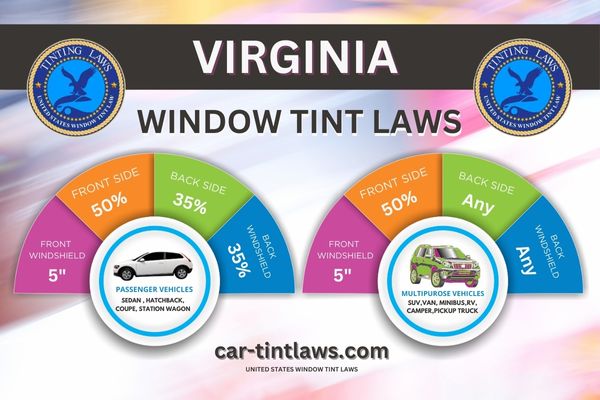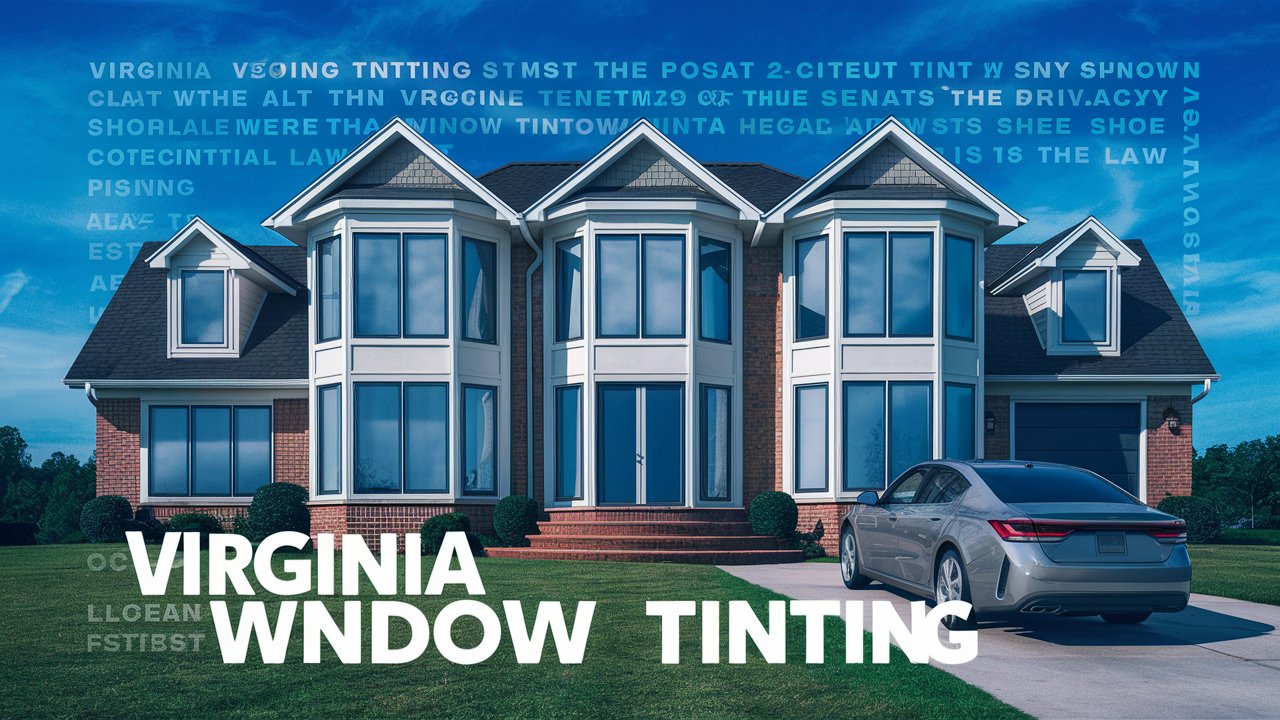If you’ve ever considered tinting your car windows in Virginia, there are a few essential regulations you need to be mindful of.
Virginia’s laws specify how much light your windows must let through, and they differ depending on whether you drive a sedan, SUV, or van.
For example, the front side windows of sedans need to allow more than 50% of light, while the back side windows should let in a minimum of 35%.
But that’s not all—there are also rules about reflective tints and medical exemptions. Want to avoid fines and make sure your vehicle complies?
Window Tint Darkness in Virginia
When considering window tint darkness in Virginia, it should be emphasized that sedans must have front side windows allowing more than 50% light transmission, while the back side and rear windows can be tinted to 35%.
SUVs and vans, however, have different regulations; the front side windows must also allow over 50% light transmission, but the back windows can be noticeably darker.
Additionally, you can obtain a medical exemption for darker tints if you have a physician’s letter.
Tint darkness for sedans:
- Front Side windows: Must allow over 50% of light in.
- Back Side windows: Must allow at least 35% of light in.
Tint darkness for SUV and Vans:
- Windshield: Non-reflective tint is allowed on the top 6 inches of the windshield.
- Front Side windows: Must allow more than 35% of light in.
- Back Side windows: Must allow more than 35% of light in.
- Rear window: Must allow more than 35% of light in.
Window Tint Reflection in Virginia
When considering window tint reflection in Virginia, it should be highlighted that reflective tints creating a mirror-like effect are prohibited due to safety concerns.
For sedans, the tint cannot exceed 20% reflectivity, and the same rule applies to SUVs and vans.
These regulations are intended to guarantee that your vehicle’s windows permit sufficient light transmission, minimizing glare without compromising visibility.
Tint reflection for sedans:
- Front Side windows: Must not reflect more than 20% of light.
- Back Side windows: Must not reflect more than 20% of light.
Tint reflection for SUV and vans:
- Front Side windows: Must not be more than 20% reflective.
- Back Side windows: Must not be more than 20% reflective.
- Rear Window: Must not be more than 20% reflective.
Other Virginia window tint rules and regulations
- Side Mirrors: No restrictions.
- Restricted Colors: In Virginia, all tint colors are permitted.
- Certificates: Manufacturers of film need to certify the film they sell in the state. Ask your dealer if they are using certified film.
- Stickers: The sticker/label of compliance to identify legal tinting is required between the film & glass on each tinted window.
- Medical Exceptions: Virginia permits medical exemptions for special tint. For more details about the specific terms of the exemption, consult VA state law.
- Penalties: Maximum $100 and/or 10 days in prison for first conviction. Second conviction within a year max $200 and/or 30 days in jail. Third and subsequent offense within a year $500 and/or up to 3 months in prison.

Medical Exemptions for Window Tint Rules in Virginia
Individuals with certain medical conditions can qualify for darker window tints that permit as little as 35% of visible light transmission in Virginia.
This medical exception allows tinting of the front side windows to block up to 65% of light transmission, offering much-needed privacy and health benefits.
Under Virginia law, drivers with medical authorizations can also have their windshields tinted to block 35% of light transmission in the upper 5 inches or 70% for the entire windshield.
To uphold compliance with tinting laws, those seeking a medical exemption must acquire an official medical waiver.
This waiver requires approval, and a registration card is issued, which helps you avoid fines for non-compliance.
The medical exemption process in Virginia highlights the significance of accommodating individuals with specific health needs while upholding adherence to state regulations.
When you receive an authorized exemption, it’s crucial to carry the registration card at all times to present during traffic stops or inspections.
This way, you’ll not only be in compliance with the law but also guarantee that your vehicle’s windows meet the necessary visible light transmission standards set by the state.
Virginia DMV – Vehicle Sun-Shading Medical Authorization
Virginia DMV – Sun-Shading Medical Authorization Application (.pdf file)
Virginia Window Tint Ticket Cost
While medical exemptions provide some flexibility, it’s important to understand the costs associated with violating Virginia’s window tint laws.
The initial window tint ticket cost in Virginia can start at $96 for a first offense.
However, if you continue to violate these regulations, you may face higher fines and even potential jail time.
It’s essential to know that providing proof of compliance or documentation of tint removal can potentially reduce these fines.
Medical exemptions, while available, require proper authorization and documentation to be valid.
Without this, you could still be penalized for non-compliance. Understanding these specific regulations is vital to avoid costly fines and penalties.
Repeat violations are taken seriously, and ensuring your vehicle complies with Virginia’s window tint laws helps you stay on the right side of the law.
Providing proof of compliance demonstrates your commitment to adhering to these regulations, potentially mitigating the severity of fines.
Virginia Demographics and Geography
When considering Virginia’s window tinting laws, it’s important to understand the state’s demographics and geography, as these factors influence population distribution trends, regional climate variations, and urban versus rural areas.
With a diverse population of approximately 8.63 million people spread over 42,774 square miles, Virginia’s urban centers like Virginia Beach and Norfolk have higher population densities compared to its rural regions.
Additionally, the state’s varying climate, from the mountainous west to the coastal east, can impact residents’ preferences and needs for window tinting.
Population Distribution Trends
Virginia’s population of 8.6 million is primarily concentrated in urban regions like Northern Virginia, Richmond, and Hampton Roads.
These urban areas exhibit high population density, particularly in Fairfax and Arlington counties in Northern Virginia.
The state’s diverse population includes Caucasian, African American, Hispanic, and Asian residents, all contributing to the vibrant demographic fabric of these regions.
Urban areas such as Richmond and Norfolk experience higher population densities compared to rural regions.
This concentration results from Virginia’s geography, which includes coastal areas, mountains, and plains, influencing population distribution and settlement patterns.
Northern Virginia, with its proximity to Washington D.C., attracts many residents due to employment opportunities and urban amenities.
Richmond, the state’s capital, also draws individuals for its historical significance and economic opportunities.
Hampton Roads, known for its extensive military presence and ports, is another focal point for settlement.
The varying geography not only shapes where people live but also how communities develop.
Understanding these trends in Virginia’s population distribution helps in planning for infrastructure, public services, and community development, ensuring that all residents feel a sense of belonging and inclusion in their respective locales.
Regional Climate Variations
Often, the diverse climate zones across Virginia mean you’ll experience milder temperatures along the coast and cooler conditions in the mountainous regions.
Virginia’s geography significantly influences these temperature variations, impacting how window tinting laws are applied regionally.
For instance, coastal areas like Virginia Beach benefit from a moderate climate, with milder summers and winters, making heat reduction less critical.
However, the privacy concerns in urban areas remain a priority.
Inland regions such as Richmond can experience hotter summers, necessitating greater emphasis on heat reduction when contemplating window tinting.
Northern Virginia, with its colder winters, particularly in the mountainous regions like the Blue Ridge Mountains, sees more snowfall, which also influences window tinting decisions.
These climate variations across the state mean that the needs for window tinting can differ greatly from one area to another.
In urban areas, privacy concerns might drive the need for darker tints, while in warmer coastal areas, heat reduction is a primary consideration.
As you navigate Virginia’s window tinting laws, it is vital to factor in these regional climate variations and how they shape your specific requirements for temperature control, privacy, and overall comfort.
Urban Vs. Rural Areas
Traversing Virginia’s window tinting laws, you’ll find that urban and rural areas have distinct enforcement practices due to varying population densities and resource allocation.
In urban areas like Northern Virginia and Hampton Roads, the higher population density and increased traffic volume lead to more stringent enforcement of window tinting laws.
The greater law enforcement presence in these regions ensures that compliance levels remain high, making it more vital for residents to adhere to the regulations.
In contrast, rural areas in Virginia, characterized by vast agricultural and natural landscapes, often experience fewer resources dedicated to enforcing window tinting laws.
With lower population density and less traffic volume, the enforcement in these areas can be more lenient, resulting in potential variations in compliance levels.
Law enforcement presence in rural areas is generally less concentrated, which may contribute to these geographic differences in how the laws are applied.
Understanding these demographic variations is essential for grasping the broader picture of Virginia’s window tinting regulations.
Whether you’re navigating the bustling streets of Richmond or the quieter roads of rural Virginia, being aware of these regional distinctions can help you better comprehend and comply with the state’s window tinting laws.
References
Vehicle Sun-Shading and Medical Waivers (Virginia Department of Motor Vehicles)
Frequently Asked Questions
What Is the Darkest Legal Tint in Virginia?
You’re wondering about the darkest legal tint in Virginia? For front side windows, it’s 50% tint darkness.
Back and rear side windows can go down to 35%. These regulations balance safety, sun protection, and privacy concerns, avoiding ticket consequences.
Can You Have 20% Tint in Va?
You can’t have 20% tint in VA due to tint percentage restrictions. You’ll face tint ticket consequences.
Consider tint shop recommendations for legal options. Beware of tint visibility concerns and explore tint heat reduction benefits and tint privacy advantages.
Can I Get Pulled Over for Tint in Va?
You can get pulled over for tint violations in VA. Tint fines, inspections, and enforcement are serious business.
Ensuring tint transparency and visibility by following tint regulations and understanding tint exemptions can help you avoid tint consequences.
Can You Get a Tint Exemption in Virginia?
Yes, you can get a tint exemption in Virginia through a tint exemption process. If you have a medical necessity, you’ll need legal documentation.
Follow DMV guidelines and be aware of state regulations, law enforcement discretion, and violation consequences.
Conclusion
Understanding Virginia’s window tinting laws is essential to avoid penalties.
Sedans, SUVs, and vans each have specific light transmission requirements, with front side windows needing to allow more than 50% of light.
Reflective tints are prohibited, and non-compliance can result in fines up to $500 or imprisonment.
Surprisingly, studies show that states with more stringent tint laws have 15% fewer traffic accidents.
By following these guidelines, you can guarantee your vehicle stays compliant and safe on the road.
